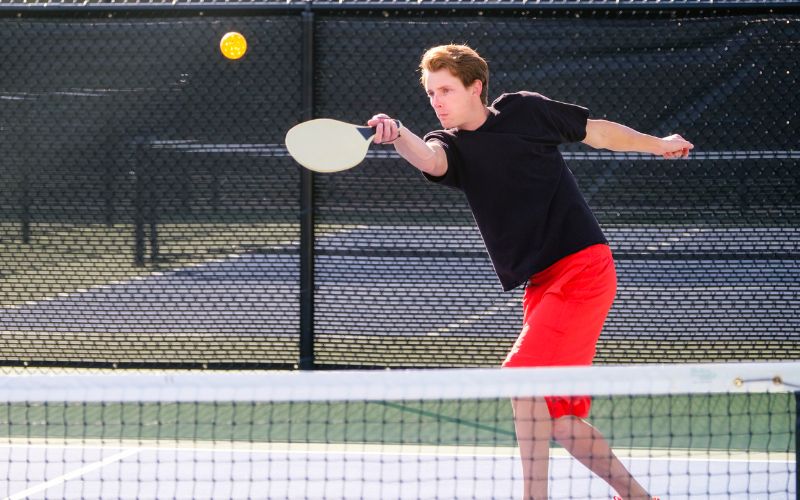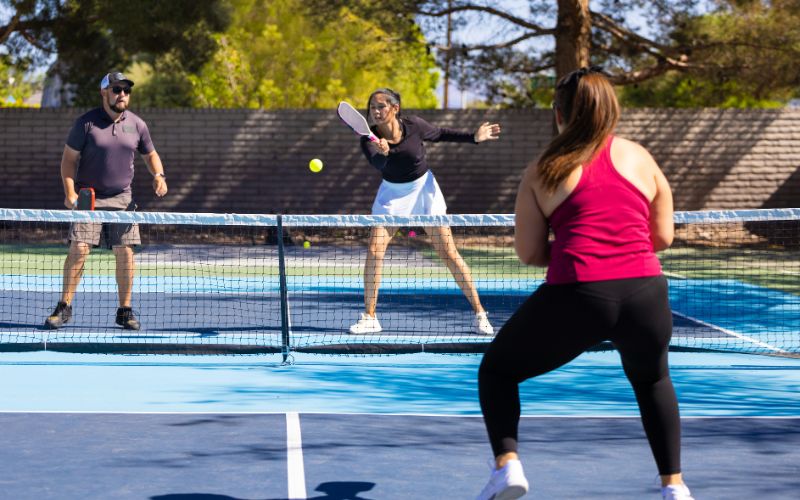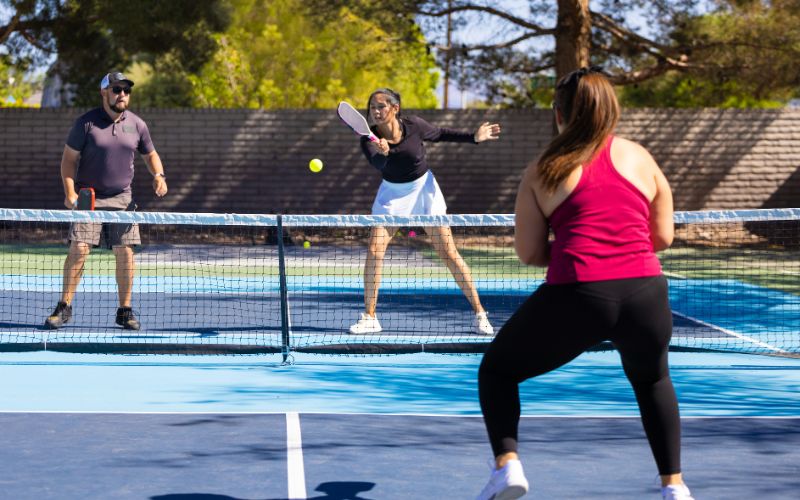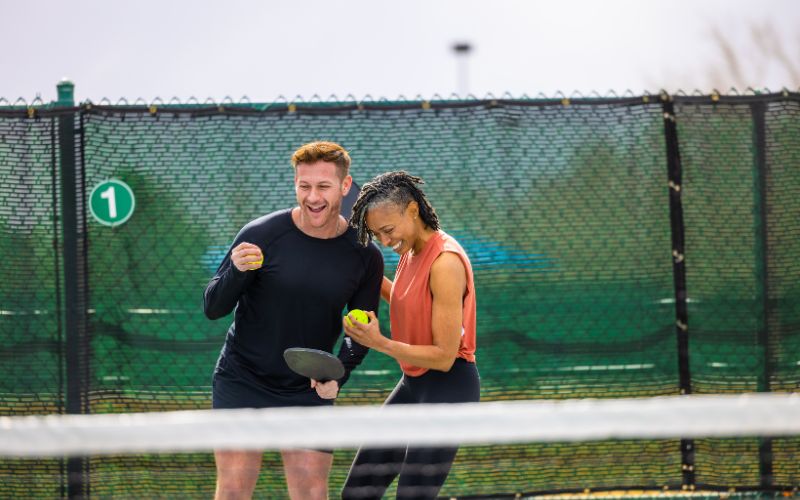Pickleball, a rapidly growing sport, has gained immense popularity for its blend of tennis, badminton, and table tennis elements. As players delve into the world of pickleball, mastering the game requires not only understanding its fundamentals but also incorporating strategic pickleball tips into one’s playstyle. Whether you’re a novice or an experienced player looking to enhance your skills, this comprehensive guide will explore various aspects of the game and provide valuable insights.
Understanding the Basics: Pickleball Court and Equipment
Pickleball Court Dimensions and Zones
Pickleball is typically played on a rectangular court divided into specific zones. The dimensions of the pickleball court are crucial for strategic positioning and gameplay. Familiarize yourself with the court’s layout, including the non-volley zone line, often referred to as the kitchen line. Staying mindful of these lines can significantly impact your gameplay, especially when executing certain shots.
Equipment Essentials: Paddle and Ball
Before delving into advanced techniques, it’s essential to have a solid understanding of the basic equipment. The paddle, often resembling a larger table tennis racket, and the plastic perforated ball are integral components of the game. Maintaining the right grip, such as the continental grip, is vital for control and versatility in your shots.
Mastering the Fundamentals: Ready Position and Reaction Time
1. Ready Position for Optimal Play
One of the fundamental pickleball tips is adopting a proper ready position. Keep your feet moving and be ready for quick movements in all directions. Ensure your knees are bent, maintaining a balanced stance that allows swift and precise responses to your opponent’s shots. A solid ready position enhances your overall court coverage and reaction time.
2. Reaction Time and Its Impact on Shots
In the fast-paced nature of pickleball, reaction time is a game-changer. From serving to returning shots, your ability to anticipate and respond swiftly can make the difference between a successful play and an unforced error. Work on improving your reaction time through focused drills and consistent practice.
3. Adopt a Balanced and Athletic Stance
Start with your feet shoulder-width apart, maintaining a balanced and athletic stance. Keep your weight slightly forward on the balls of your feet to enable quick movements in any direction. Bend your knees slightly, ensuring flexibility and agility in your stance.
4. Position Your Paddle and Body
Hold your paddle with a comfortable grip, such as the continental grip, allowing for versatility in your shots. Keep the paddle in front of you at waist height, ready to react to incoming shots.
Orient your body sideways to the net, presenting a smaller target to your opponents and optimizing your reach.
5. Constant Movement of Feet
Avoid standing still on the court. Keep your feet moving at all times to stay nimble and ready for quick lateral or forward/backward movements. Small, quick steps are more effective than large strides, allowing for better balance and responsiveness.
6. Anticipate Opponent’s Moves
Develop the ability to anticipate your opponent’s shots by reading their body language and racket position. Pay attention to the positioning of your opponents and be ready to react based on cues such as their shoulder movements and paddle angle.
7. Eye Focus on the Ball
Keep your eyes focused on the ball at all times. Avoid getting distracted by your opponents’ movements or the overall game situation. A laser-like focus on the ball enhances your reaction time and allows you to better predict the trajectory of the shot.
8. Practice Reaction Drills
Engage in specific drills that target reaction time improvement. These can include rapid ball exchanges with a practice partner or using a ball machine to simulate varying shot speeds and angles. Gradually increase the complexity of the drills to challenge and enhance your reaction capabilities.
9. Maintain Mental Alertness
Stay mentally alert and avoid zoning out during the game. A proactive and focused mindset contributes significantly to quick decision-making and timely reactions. Be aware of the game situation, score, and your opponents’ playing styles to tailor your readiness accordingly.
10. Fine-Tune Your Split-Step Technique
Incorporate the split-step into your ready position. This involves a quick hop or shuffle step just before your opponent makes contact with the ball.
The split-step positions you optimally for a rapid response, enabling you to push off in any direction to reach the incoming shot.
11. Consistent Practice for Muscle Memory
Regularly dedicate time to practicing your ready position and reaction time. Consistent practice builds muscle memory, making these movements second nature during a game. Include solo drills and practice sessions with a partner to simulate real game scenarios.
12. Analyze and Learn from Your Mistakes
After each game or practice session, analyze situations where your reaction time could have been better. Learn from mistakes and identify areas for improvement. Adjust your approach accordingly in future games.
Strategic Shot Selection: Third Shot and Drop Shot
Third Shot Strategies
The third shot is a pivotal moment in pickleball, often determining the course of the game. Developing a strong third shot, characterized by a well-placed and controlled ball, is crucial. Aim to position the ball accurately, allowing your team to approach the kitchen line with an advantageous stance.
Mastering the Drop Shot
A well-executed drop shot can catch your opponents off guard, creating opportunities for strategic plays. Focus on varying the pace and trajectory of your shots, incorporating the drop shot into your arsenal. This versatile shot, when played with precision, can be a game-changer, forcing your opponents to adapt to your dynamic playing style.
Navigating the Court: Cross Court and Dink Shot Strategies
Cross Court Plays for Tactical Advantage
Understanding when and how to play a cross-court shot adds versatility to your game. By directing the ball diagonally across the court, you can exploit openings in your opponent’s defense. However, it’s crucial to use this shot judiciously, as over-reliance may lead to unforced errors.
The Art of the Dink Shot
Mastering the dink shot is essential for both defensive and offensive play. This shot involves gently tapping the ball over the net, keeping it low and close to the net. A well-placed dink shot can put pressure on your opponents, forcing them into difficult positions and setting the stage for a strategic advantage.
Elevating Your Gameplay: Advanced Techniques and Strategies
Shot Diversity: Expanding Your Arsenal
Successful pickleball players showcase a wide range of shots. From powerful drives to delicate dinks, having a diverse set of shots in your repertoire keeps opponents guessing. Experiment with different shot techniques during practice sessions to build confidence in your ability to adapt to various game scenarios.
Team Dynamics: Partner Communication and Coordination
For those playing in doubles, effective communication with your partner is paramount. Establish clear signals and develop a synergy that allows for seamless coordination on the court. Understanding your partner’s strengths and weaknesses enables both of you to cover the court efficiently and capitalize on each other’s skills.
Strategies for Consistency and Control: Practice and Focus
In the realm of pickleball, achieving consistency and control is paramount for success on the court. Developing effective strategies for both practice sessions and actual gameplay is crucial to elevate your skills. Let’s delve deeper into the strategies that can enhance your performance and help you maintain control during pickleball matches.
1. The Importance of Regular Practice
Consistent practice is the cornerstone of improvement in any sport, and pickleball is no exception. Target specific areas of weakness, such as your serve or backhand, and dedicate focused practice sessions to address these aspects.
Consistency in performance stems from regular and purposeful practice. Start practicing regularly to refine your techniques and build muscle memory. Dedicate specific time slots for pickleball practice to hone your skills and build muscle memory. Whether you’re focusing on improving your serve, perfecting your shot drop, or working on your overall court movement, consistent practice is the key to refining your techniques.
2. Maintaining Control
In the heat of a game, maintaining focus is crucial. Avoid getting flustered by unforced errors or difficult shots from your opponents. Cultivate a mindset that allows you to stay calm and composed, even in challenging situations. This mental resilience contributes significantly to your overall performance on the court.
3. Target Weaknesses during Practice
Identify and address the areas of your game that need improvement. If you find your high percentage shot lacking accuracy or your hitting balls technique inconsistent, focus on these aspects during practice. By targeting weaknesses systematically, you can gradually eliminate them and build a well-rounded skill set.
4. Incorporate Variety in Your Shots
Practice should not be monotonous. Experiment with various shots during your sessions to diversify your playing style. Incorporate the shot drop into your repertoire and refine your ability to execute a high percentage shot consistently. This variety not only keeps your practice engaging but also prepares you for different scenarios on the court.
5. Maintain a Focused Mindset
During both practice and actual gameplay, maintaining focus is a game-changer. Avoid distractions, stay present in the moment, and concentrate on each shot. Focused gameplay allows you to react swiftly to your opponent’s moves, reducing the chances of unforced errors and enhancing your overall control on the court.
6. Develop Mental Resilience
Pickleball is not just a physical game; it’s equally demanding mentally. Embrace challenges as opportunities to learn and grow. If a difficult shot or a series of unforced errors occurs, stay composed and refocus on the next point. Mental resilience contributes significantly to maintaining control and consistency throughout a match.
7. Simulate Game Situations in Practice
Incorporate drills that simulate actual game scenarios during practice. Work on your third shots, practice defending against opponents at the net, and simulate fast-paced rallies. By exposing yourself to various in-game situations during practice, you’ll be better prepared to handle them during a live match.
8. Partner Communication and Coordination
If you’re playing doubles, effective communication with your partner is crucial. Develop signals and strategies to coordinate movements and shots. A well-coordinated team can control the pace of the game, making it challenging for opponents to anticipate your moves.
9. Strategic Use of the Non-Volley Zone Line
Understanding the nuances of the non-volley zone line is essential for controlling the game. Strategic positioning along this line can dictate the flow of play, allowing you to set up advantageous shots and maintain control over the pace of the game.
10. Analyzing and Adapting to Opponents
Pay attention to your opponents’ playing styles and adapt your strategy accordingly. If they struggle with a particular shot, exploit that weakness. Similarly, be flexible in your own strategy, adjusting to the strengths and weaknesses of your opponents to maintain control of the game.
11. Stay Calm under Pressure
In high-pressure situations, maintaining a calm demeanor is crucial. Whether you’re facing a match point or navigating a challenging rally, keeping a level head enhances your decision-making and shot execution. Cultivate a mindset that embraces pressure as an opportunity rather than a hurdle.
Expert Insights: Learning from the Best – Dave Weinbach’s Tips
Dave Weinbach’s Impact on Pickleball
As one of the prominent figures in the pickleball community, Dave Weinbach’s insights are invaluable for both beginners and intermediate players. Weinbach emphasizes the significance of maintaining a balanced ready position and the importance of third shots in dictating the flow of the game.
Key Takeaways from Dave Weinbach’s Tips
Weinbach’s focus on placing shots strategically, implementing effective strategies, and maintaining court awareness deeply connects with players aspiring to enhance their skills. Integrate these recommendations into your practice routine to develop a profound comprehension of the subtleties that contribute to successful pickleball gameplay. Embracing these insights will significantly improve your ability to execute a high percentage shot, master the shot drop, and enhance your prowess in hitting balls with precision on the court.
Conclusion: Succeeding on the Pickleball Court
Mastering pickleball involves a combination of fundamental skills, strategic shot selection, and a proactive approach to gameplay. Whether you’re aiming to enhance your third shot, perfect your drop shot, or improve overall court awareness, these pickleball tips provide a comprehensive guide for players of all levels. Remember to stay patient, stay focused, and most importantly, enjoy the dynamic and exhilarating experience that pickleball offers.
Frequently Asked Questions (FAQs) about Pickleball Tips: Mastering the Art of the Game
1. What is the significance of the non-volley zone line in pickleball?
The non-volley zone line, often referred to as the kitchen line, is crucial in pickleball as it dictates player movement and shot selection. Staying mindful of this line is essential for strategic positioning, especially when executing shots close to the net.
2. How can I improve my high percentage shot accuracy in pickleball?
Improving your high percentage shot accuracy requires targeted practice. Identify weaknesses in your shot accuracy during practice sessions and focus on refining your technique. Consistent practice and incorporating variety into your shots will enhance your ability to execute high percentage shots with precision.
3. What is the key to maintaining control during a pickleball match?
Maintaining control in pickleball involves a combination of factors, including regular practice, staying focused, and developing mental resilience. Targeting weaknesses, incorporating shot variety, and simulating game scenarios during practice contribute to better control during actual gameplay.
4. How can I effectively communicate with my doubles partner in pickleball?
Effective communication with your doubles partner is crucial for success. Establish clear signals and strategies to coordinate movements and shots. A well-coordinated team can control the pace of the game, making it challenging for opponents to anticipate your moves.
5. What is the role of mental resilience in pickleball?
Mental resilience is essential in pickleball as it helps players stay composed and focused, even in challenging situations. Embracing challenges as opportunities to learn and grow, and maintaining a calm demeanor under pressure, significantly contributes to overall performance and consistency on the court.







